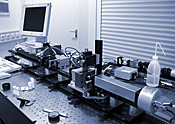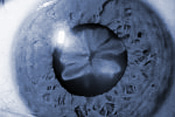IOL test - comparative measurements of the imaging quality of intraocular lenses (IOL)
Goal
The Institute of Information Processing Technology (ITIV) has many years of experience in the field of optical design, in particular in the design of bifocal intraocular lenses (IOL) and in the field of optical measurement technology in the biomedical environment, especially in ophthalmology.

Based on this knowledge, the institute has developed a highly accurate measuring stand for determining the imaging quality of IOLs in accordance with the international industry standard EN/ISO 11979-2 [ISO 11979] . With the help of this measuring system, the Institute provides independent expert opinions on the imaging quality (optical quality) of IOLs.
Since a large number of new IOL designs have flooded the market in recent years and their optical quality varies greatly in some cases, we would like to offer an independent forum for comparison. On this page we therefore publish comparative measurement results of the imaging quality of a wide range of IOLs from different manufacturers. Companies, doctors and private individuals can also request corresponding measurements.
Background

The implantation of intraocular lenses (IOL) is the most common surgical procedure in ophthalmology, with over 700,000 operations in Germany alone. The reason for this high number of operations is the fact that almost 99% of Central Europeans over the age of 65 develop a so-called cataract, in which the natural lens of the eye gradually becomes cloudy over decades. This natural ageing process leads to extensive blindness in the advanced stage (see illustration opposite) and can generally only be treated by surgically removing the natural lens of the eye and implanting an artificial IOL.

The quality of the IOLs available on the market varies considerably in some cases.
The most important quality feature for the subsequent optical function of the artificial IOL in the patient's eye is the so-called image quality. This depends on the optical design used (exact geometric shape) and the quality of the surfaces produced (e.g. roughness) or the material used. High image quality is the basis for the patient's optimal vision after successful implantation.
Basic principles
As a whole series of technical and medical correlations must be taken into account when measuring the imaging properties of IOLs, the following basic principles are summarized here:
- Imaging quality
- What is it? Which optical and medical correlations are relevant?
- Imaging errors
- Which aberrations are relevant in ophthalmology? How do they arise? How can they be avoided?
- Design differences of common IOLs
- What different optical designs are available on the market? What are their advantages and disadvantages?
- Quality criteria used
- How can different IOLs and different designs be compared easily and objectively?
Measurement results
Comparative measurements of the imaging properties of different IOLs are carried out on the basis of this measuring system. The measurement results are published on these pages according to lens type and are intended to serve as an independent source of information for doctors and patients.
The comparative measurement results are divided into the following categories:
- Summarized comparison of measurement results
- Individual results of symmetrical spherical IOLs
- Individual results of asymmetric spherical IOLs
- Individual results of aspheric (so-called aberration-corrected) IOLs
- Individual results of bifocal/multifocal IOLs
- Summary of the injector test for foldable IOLs
Service
Please send inquiries to: Prof. Dr. rer. nat. Wilhelm Stork, Tel. 0721 / 608 - 42510, wilhelm stork ∂does-not-exist.kit edu
for companies
The Institute offers the preparation of a wide range of independent expert reports (e.g. in accordance with EN/ISO 11979-2), which are typically required for quality assurance in the development process and during production or for approval by the European or American health authorities (FDA). The results can also be published on these pages on request.
for doctors & private individuals
We offer the service of measuring individual IOLs according to the industry standard EN/ISO 11979-2 at cost price, especially for practicing doctors and private individuals. This gives you the unique opportunity to obtain independent, precise measurement results for the IOLs you are interested in.
Miscellaneous
In addition to these contract assessments, comparative measurements of the imaging quality of current IOLs are carried out continuously.
Analogous to the measurement of IOLs, the imaging quality of (multifocal) contact lenses can also be measured in the measuring system.
Contact
Prof. Dr. rer. nat. Wilhelm Stork
Tel. 0721 / 608-42510, wilhelm stork ∂does-not-exist.kit edu
Publications
Lectures
R.Rawer:
Comparison of the imaging quality of hydrophobic acrylic intraocular lenses with and without blue light filter before and after injection through a cartridge Symposium: Hydrophobic acrylic intraocular lenses with and without blue light filter, International exchange of experience on a new generation of intraocular lenses, Vienna, October 2004
R. Rawer, W. Stork, C. Lingenfelder, C.W. Spraul:
Analysis of the optical imaging quality of foldable Intra Ocular Lenses (IOL) before and after injection through a cartridge by comparative measurement of the Point Spread Function (PSF) according to ISO Standard,
XXII Congress of the European Society of Cataract and Refractive Surgeons, Paris, 2004
R. Rawer, W. Stork, C. Lingenfelder, C.W. Spraul:
Comparative measurement of the optical imaging quality of foldable Intra Ocular Lenses (IOL) by analysis of the Point Spread Function (PSF) according to ISO Standard before and after injection through a cartridge,
102nd Annual Meeting of the German Ophthalmologic Society (DOG), Berlin, 2004
Book contributions
[Rawer05b] R.Rawer:
Comparison of the image quality of hydrophobic acrylic intraocular lenses with and without blue light filter before and after injection through a cartridge
Symposium: Hydrophobic acrylic intraocular lenses with and without blue light filter, edited by S. Binder, R. Welt, R.D. Gerste, ad manum medici Verlag für Medizin und Naturwissenschaften, Germering, ISBN 3-928027-25-5, 2005, p.15-24
Journal articles
[Rawer05c] R.Rawer, W.Stork, C. Lingenfelder, C.W. Spraul:
Comparative measurements of the imaging quality of foldable Intraocular Lenses by analysis of the point Spread Function (PSF) according to ISO requirements before and after injection through a cartridge
Graefe's Archive for Clinical and Experimental Ophthalmology, submitted August 2004
[Spraul05] C.W. Spraul, R.Rawer, W. Stork, P. Walther, C. Lingenfelder, G.K. Lang:
Does the orientation of an IOL in the eye play a role?
Klinische Monatsblätter für Augenheilkunde, submitted January 2005
[Rawer05a] R. Rawer, W. Stork:
Imaging Quality of Intraocular Lenses,
ESCRS, Journal of Cataract & Refractive Surgery, 31/8:1618-163, August 2005
[Eisenmann93] D.Eisenmann, V.Hessemer, B.Manzke, W.Stork, K.W. Jacobi:
Modulation transfer function and contrast sensitivity of refractive multizone multifocal lenses
Ophthalmologist, 90:343-347, 1993
Further literature references on this topic can be found under Literature.
Sponsors
*Acri.Tec 
Company for ophthalmic products MBH
PolyTECH 
Ophthalmology GmbH

